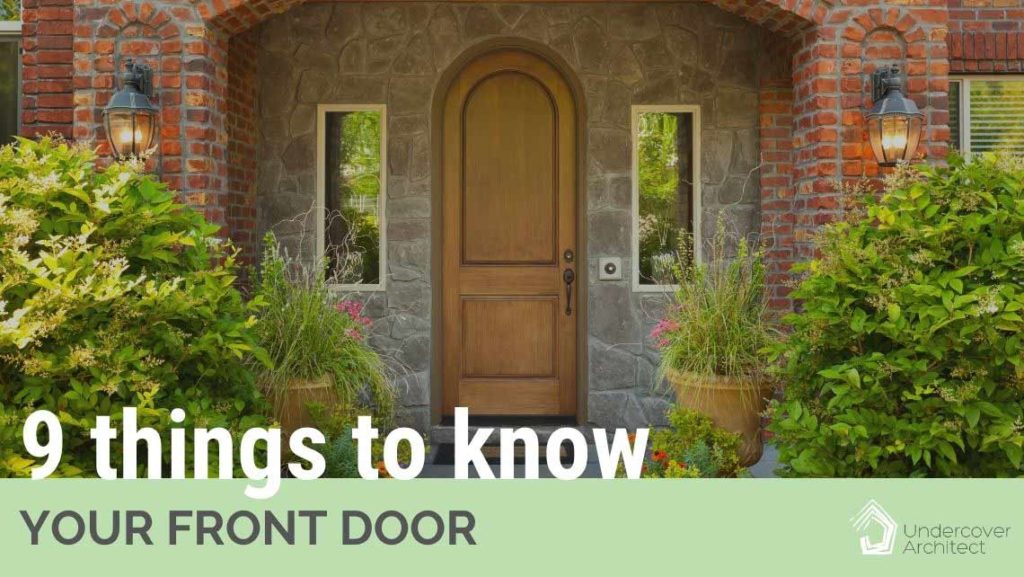
What are the key things to know about your Front Door so you can create a welcoming and comfortable home?
Consider how you’ll design your front door, and the experience of entering your home, so that it enhances the overall aesthetic of your home, and sets up the type of feeling you want your home to have from the start.
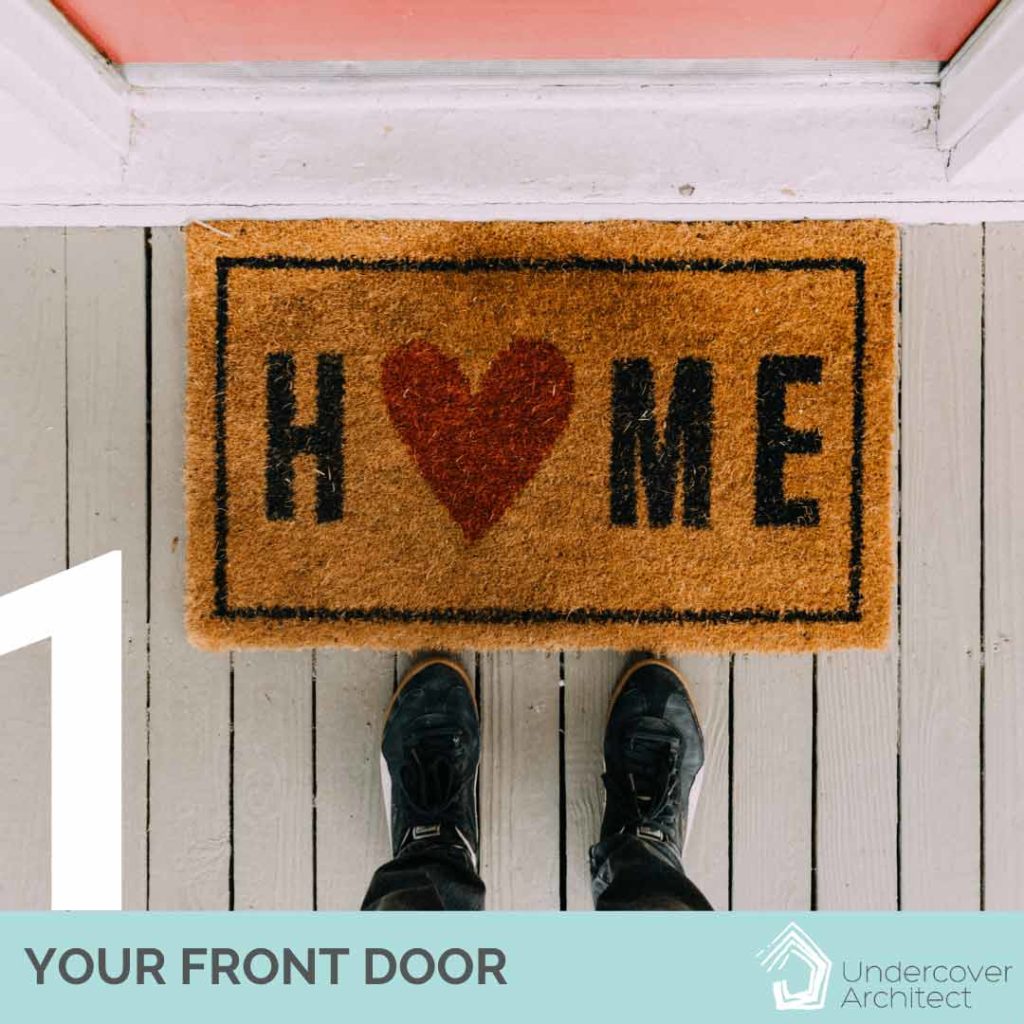
Image Source @Canva
A Welcoming Entry
Many homeowners tell me they want a welcoming home. One that makes people feel comfortable, and embraces all those who visit it with warmth. And your front door plays a big part in helping start that experience for visitors. And you, if you don’t have a garage with an internal entry.
What does the front door tell people about what awaits inside? Front doors come in so many different sizes, detailing and materials, that you can choose one to celebrate the aesthetic style of your home, and give your front elevation a lot of character.
It’s not only the door itself that you can play with. What can you choose for door knockers, and door handles? What happens around the door? On the landing, on the ceiling, on the walls? And in the pathway up to it as well?
Consider how you can invest in something that really celebrates the entry to your home, and brings joy on a daily basis as you welcome people through it.
Far too often, we plonk a door in a wall, and create a small covered entry that simply feels like a pit stop before we let someone inside (or choose not to!)
An architect I worked for very early in my career always reminded me to consider how things felt to touch – not just to look at – and the importance of creating surfaces and choosing materials that we wanted to touch at our ‘tactile height level’. That is – where we walk past, put our hands on, as we move through a space. This can dramatically change the experience of entering your home.
Making the entry process one that flows, and that feels easy and comfortable, with moments of joy and delight, can be such a beautiful way to enhance the experience of arriving at your home.
And when you think about how that relates to what’s going on inside your home, and create some continuity with colours, materials, detailing or design ideas, this can be a very strong way to improve that sense of flow in and beyond your home.
You don’t need a lot of space. It doesn’t have to be big to be welcoming. Use the design of your front door and entry to start telling your story, and highlight elements that create interest and anticipation of what’s inside.
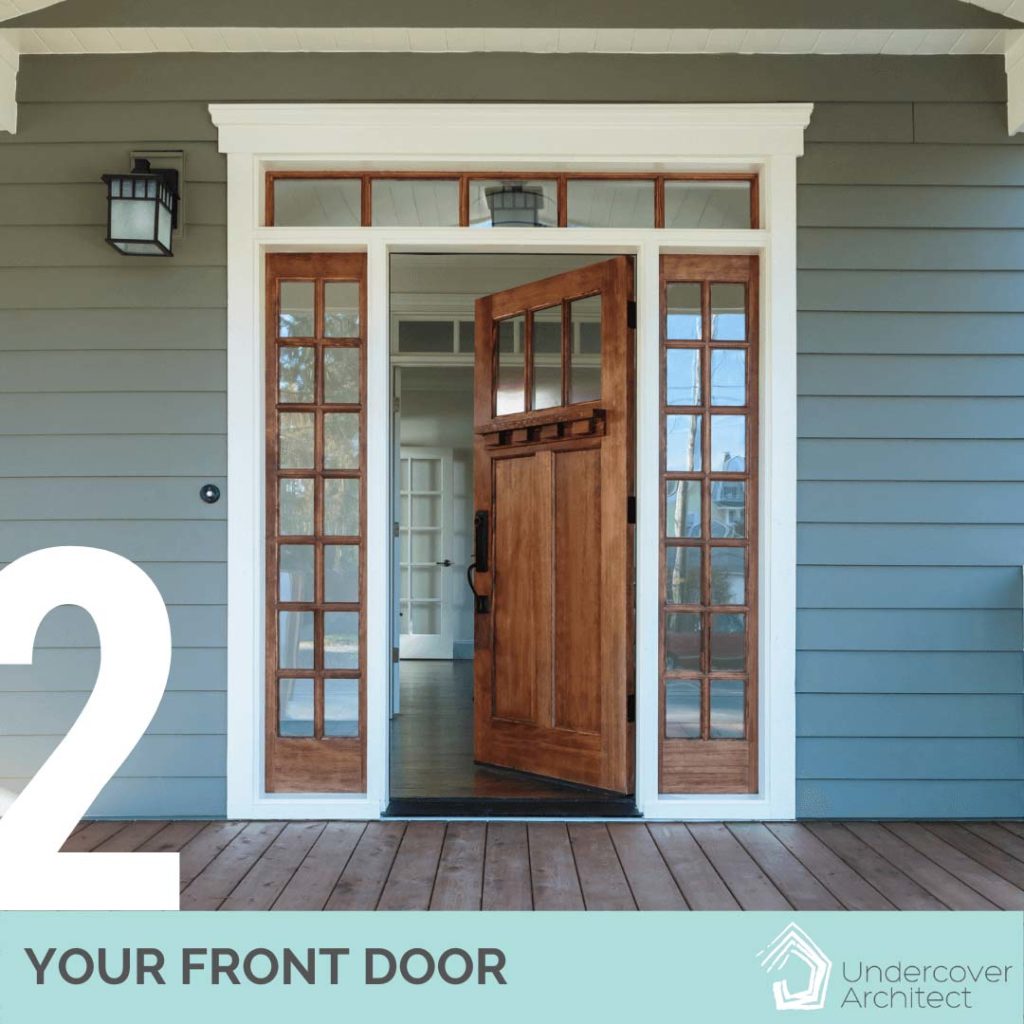
Image Source @Canva
Visibility from the street
When positioning your front entry to your home, consider how visible it will be from the street, so visitors know clearly where to go, to announce their arrival at your home.
This helps with the overall security of your home, because the design tells people how they need to interact with your home’s entry.
You can do this by making the door very visible from the street, through its location, its colour, and the landscaping and building treatment leading up to it.
In a narrow lot, where a side entry may be needed (and the door not directly visible from the street), consider using other elements to highlight where the front door is. A well-landscaped and delineated front entry path. A projecting roof or awning to bring people to that side entry. Changes in colour or materials. Things that draw the eye.
Highlighting where your front entry is, and showing people clearly where to go, also helps privatise anything else that is at the front of your home.
Consider what will happen if they decide to drive in and park on your driveway. How will they get from their car to the front door and maintain the privacy of your home? Give them somewhere clearly demarcated to walk that enables a clear pathway of entry to your front door.
If they’re walking past other parts of your home as they arrive at the front door, consider how you’ll maintain the privacy of those spaces. There are so many designs that have a trio of narrow windows on the front of the house for privacy or interest. Those thin narrow windows (horizontal or vertical) mean internal window furnishings are strange, and views and light for that room are compromised.
Look at the landscaping design, or the distance you keep people away from that space with where pathways are positioned, or the angle at which they can look into the room.
Design tells us how to move, where to walk, what to look at, how to behave, in our everyday lives all the time. We’re not always aware that this is happening, but that doesn’t stop it working! We can do this to help improve our home’s security, privacy and overall feeling as well. And we can do this from the moment someone sees our home from the street.
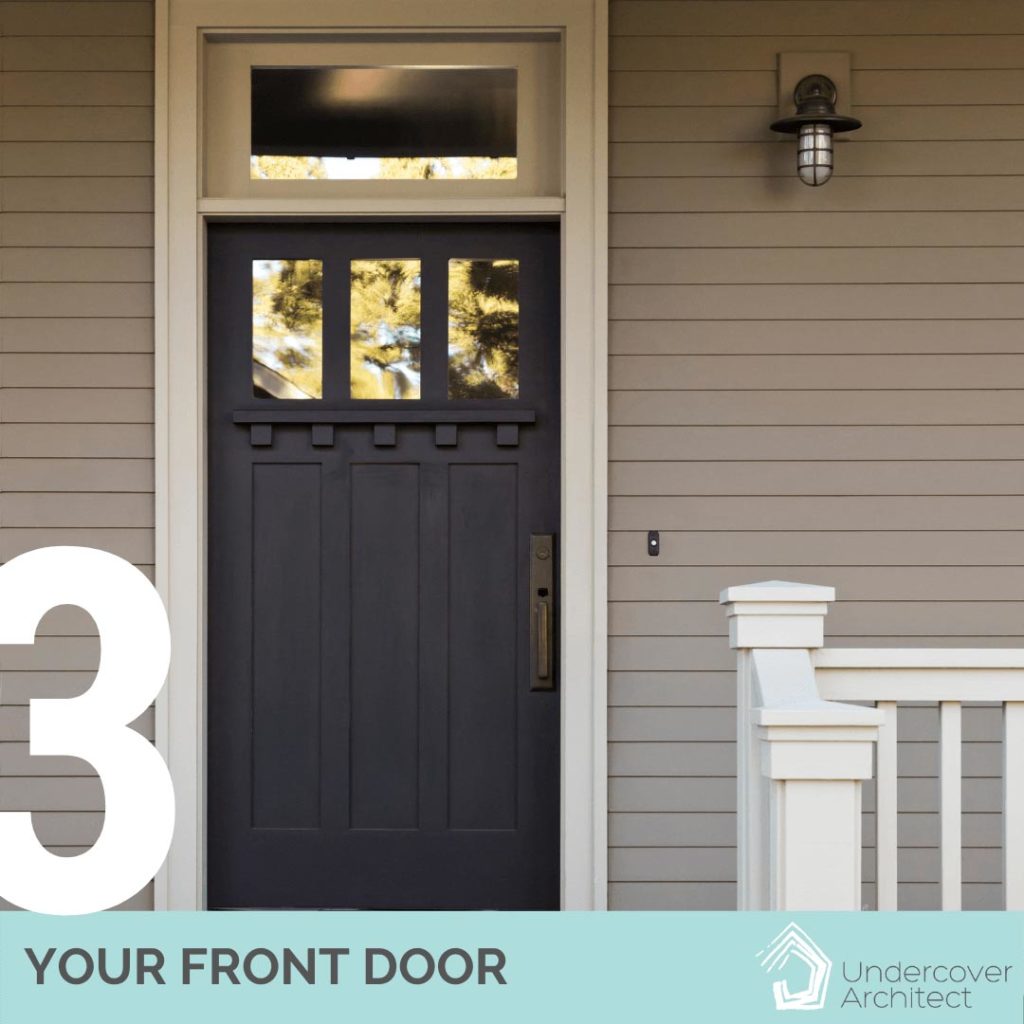
Image Source @Canva
Security
Our front door security doesn’t only come from the physical locks we put on it. You can create security through design.
Consider the idea of ‘threshold’. The entry door itself is a big threshold moment between the public world of your street and front garden … into the private world of your home’s interior. However, what other thresholds can you create (through design, materials, built elements) between the front door and the street?
Changing levels can be a great threshold. Think of large public buildings. You walk up a large set of stairs to ‘arrive’ – and in doing so, you leave the public domain. Entering the building feels more special and ceremonial. This idea can work on a smaller scale when navigating levels at your home’s entry.
Landscaping can also create thresholds, and material and colour choices do as well.
The visibility of your entry from the street will also improve security, as it makes it difficult for someone to be loitering unnoticed around your front door. When you have a side entry, ensure you still create good physical and visual separation between your ‘front’ yard, and ‘back’ yard at that entry point – so it’s difficult for someone to continue down the side of the home unnoticed.
Also review ‘surveillance’. This is where you’re able to maintain visibility on the door and entry itself – or the impression of visibility. Some do this by adding sidelights to their door (which can create privacy problems for your home’s interior). Some do this by adding a peep hole, or by including intercom cameras. However, perhaps your surveillance comes from an adjacent room, or a living space at the front of the home that has ‘eyes’ on the street, and anyone who enters your site.
You can of course, create mechanical means of security. Good locks. Security screen doors. Alarms. Cameras. However, this can often be at odds with creating a welcoming and comforting feeling that’s so important for our homes. Think about the design and what it can do to create security. Pay attention to the spaces you’re moving about to see how others have used design to do this too.
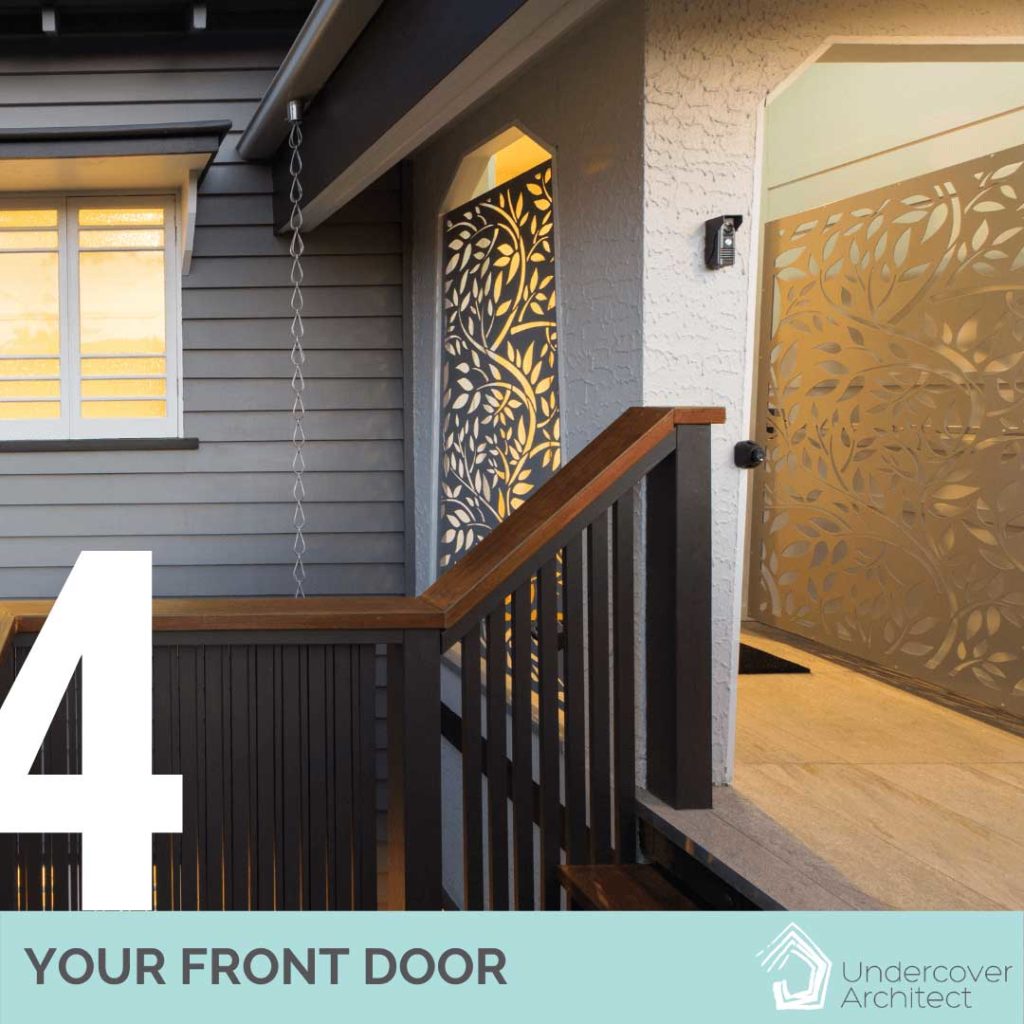
Image Source @Canva
Providing Ventilation (including a screen door)
With many narrow lots and smaller homes, the front door can be one of the few openings at the front of the home.
In addition, it can also be the end of a hallway, which can act as a fantastic breezeway, if the door can be left open (and secure) to provide natural ventilation. In smaller homes, or on narrow lots, this can make a huge difference to how the home feels and performs overall.
Consider whether you’ll want to leave your door open more regularly when you’re home. You can then include some type of security screen door that stays locked, but means you can leave your front door open and get those breezes into the home.
Security screens can be a way to add another layer of character and aesthetic to your home. From simple, geometric patterns, to custom-made laser-cut screening, you can access some fantastic options as a lovely feature on your home.
The home in this image is the entry of one of the homes my husband and I renovated. The screen door was custom made to suit the shape of the existing entry, and we used to for screening in that space as well. I chose a laser-cut pattern in powder-coated aluminium that highlighted the history of the site as an orchard. This pattern also still gave privacy and security to the door. Someone couldn’t slide their hand through to unlock the door from the outside as a result!
(Many people want to leave their key in the lock inside for convenience, but having a screen door that’s easy for someone to slot their hand through and unlock from the outside will create problems!)
Remember too, that your screen / security door will most likely open outwards. So, when designing your entry landing, accommodate sufficient space for the door swing. That way you won’t knock someone off your entry when you need to open the security door to let them inside!
And if you’d prefer to see your front door from the outside, you can always have it open outwards, and locate your screen door on the inside. It’ll just mean selecting a certain type of door jamb and hinge to enable this.
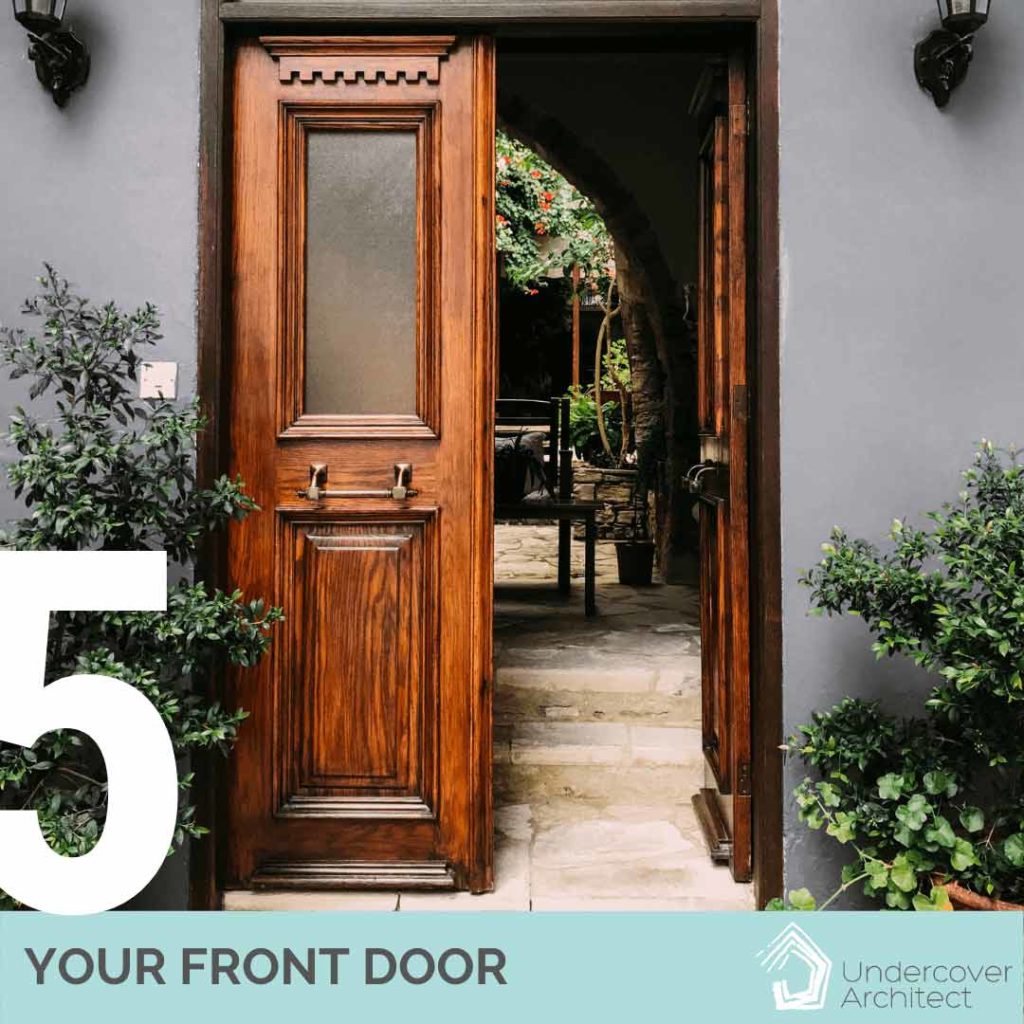
Image Source @Canva
The moment you arrive HOME
There is a moment I describe to homeowners about their home, and what to aim for in their design. It’s the moment when you feel “I’m home”.
The moment when you walk into your home, put down your things, and your shoulders drop. The moment when you connect with the things you love about your home and site (views, design of space, quality of light, colours, materials). It’s the moment of the exhale when you connect with the feelings of relaxation. It’s the moment when you actually arrive HOME.
This moment may happen at your front door, as soon as you open the door to reveal your home’s interior. It may be a moment you’re willing to share with any visitor that comes to your home, and steps inside.
Or, it may be a more private moment, and something you want to experience and save for only those closest to you who are welcomed into, or live in your home.
Think about what experience you want to create, because opening your door ‘reveals’ your home to anyone on your doorstep instantaneously. Design the experience.
Do you want to privatise your home’s interior, and only allow those who are welcomed inside to see it? If so, look to create a small and privatised entry zone on the inside of your front door.
Be careful of creating dog-legging hallways that are tight and dark though. They’ll kill the feeling of spaciousness in your home. Ensure there’s sufficient natural light in this space so you don’t suffer a contrast adjustment every time you open the front door.
If you are happy to reveal more of your home, then you can align the front door with your main hallway as a circulation axis into and through your home. This can be great for keeping things ordered.
Create sufficient space at the front door that your visitors can step inside, and you can move around them to close the door, and then in front of them to lead them into your home.
If you’re using a void at your entry, lead the eye to somewhere meaningful (a focal light fitting, up a set of stairs, to a high level window). Be careful you don’t create a vertical tunnel at the entry which feels noisy and cavernous to stand in.
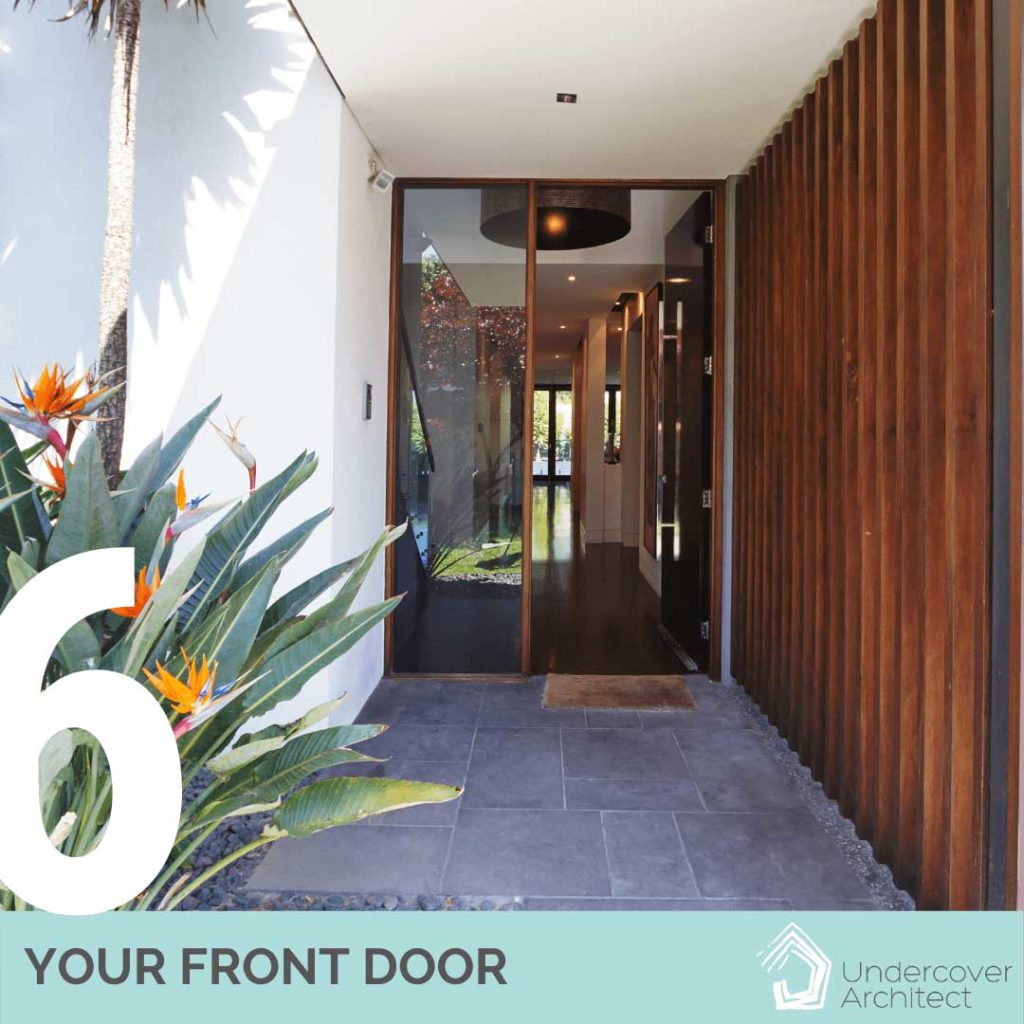
Image Source @Canva
Light (Day and night)
Natural light at your entry will make it feel more welcoming, and help with a sense of spaciousness. And if you’re dealing with a narrow site and / or home, then natural light at your front door may be necessary to avoid a dark entry hallway.
Entry doors come in all sorts of designs and configurations now, with glass included in lots of different arrangements – either in the door, or as sidelights.
However, many compromise the privacy and security of their home’s entry by the door that they choose.
A few things to think about if considering glazing in your front door (or in a window or sidelight nearby):
>> will privacy be an issue?
>> does the glass need to be transparent (could you choose an obscure glass, or add a an adhesive film for part or all of the glass)?
>> do you need to have the glass at eye level (or could it be above or higher in the door?)
>> can you provide thresholds or gateways before your front door (so not everyone gets up to the door itself unless ‘let in’)
Also consider your night time lighting. Choose lighting at your front door for function and appearance, so you can create a secure and welcoming entry at any time of the day.
There are loads of options for night lighting:
>> downlighting in soffit of roof over entry
>> pendant lighting (careful how the wind impacts it)
>> wall lighting (it doesn’t have to be symmetrical)
>> in low landscape walls
>> in the entry landing itself
Invest in great quality exterior lighting at your front door, to really enhance the look of your home overall. The type of light fixtures you choose will also start to tell the story of your home’s aesthetic, so consider how they integrate with what you’re choosing internally in your home (shape, fixture colour, type of light, etc).
And ensure functionally, it’s really safe and secure to approach your front door of an evening.
If you have some transparency at your front door (due to sidelights or glass panels in the door itself), consider how your interior lights will also light the entry space.
If using sensor lighting, ensure you have a set up that doesn’t get triggered when the wind blows through trees, etc. You’ll drive yourself and your neighbours bonkers.
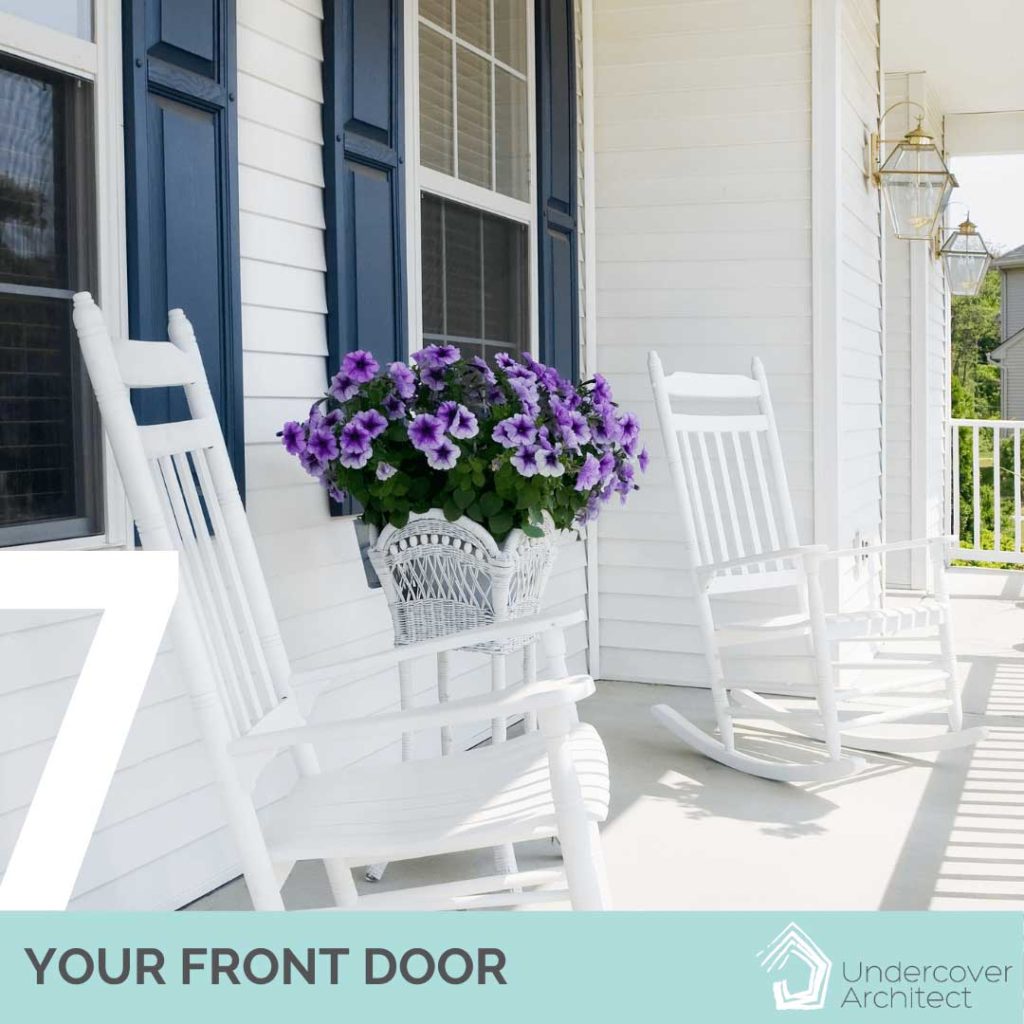
Image Source @Canva
Your Front Landing
In years gone by, many homes would have a front porch or deck with a collection of chairs and a place to sit and watch the world go by. Chatting to neighbours walking past, and interacting with the street generally, was common-place.
Now, front doors and front landings can be tight spaces which are simply about ‘getting in’ to the home. With little cover and a tiny space to stand whilst you knock at the door. All the space is dedicated to inside the home instead.
Creating a well-designed front landing can do lots of things for your home – even in the most compact of designs. Here are some things to think about …
>> Orientation
If your home is south or west to rear, you may want to create a seating area at your home’s entry so you have a spot to sit in the sun that’s different from your rear exterior spaces. This can be great in Winter time, and it can help with the overall feeling you have in your home.
>> Weather and shade
It’s important to provide overhead protection at your front door – not only for visitors to have somewhere dry or shaded to stand whilst they wait for you to open the door, but also for the long-term durability of your door itself.
>> Deliveries
With all the online shopping happening these days, chances are you’re receiving a fair few deliveries at home. Design a front door and entry that makes it easy for packages to be left in a hidden and fairly secure place when you’re not home.
>> Light and Shade
There’s something known as ‘articulation’ when designing the exterior of homes. Put simply, this is how walls, roofs, and other surfaces, step in and out to create shadow on a facade, and general interest in the appearance of the home. Think modern homes that can appear quite ‘flat’ to the street, vs old Queenslanders with deep verandahs and shadows. Specific articulation can help emphasise the aesthetic you’re chasing, create a more welcoming entry, and may also be required by your local town planning rules.
You can be generous in your design of your front landing, without chewing up a lot of physical space. Design your front landing AS you design your home – don’t leave it as an afterthought you bolt on at the end.
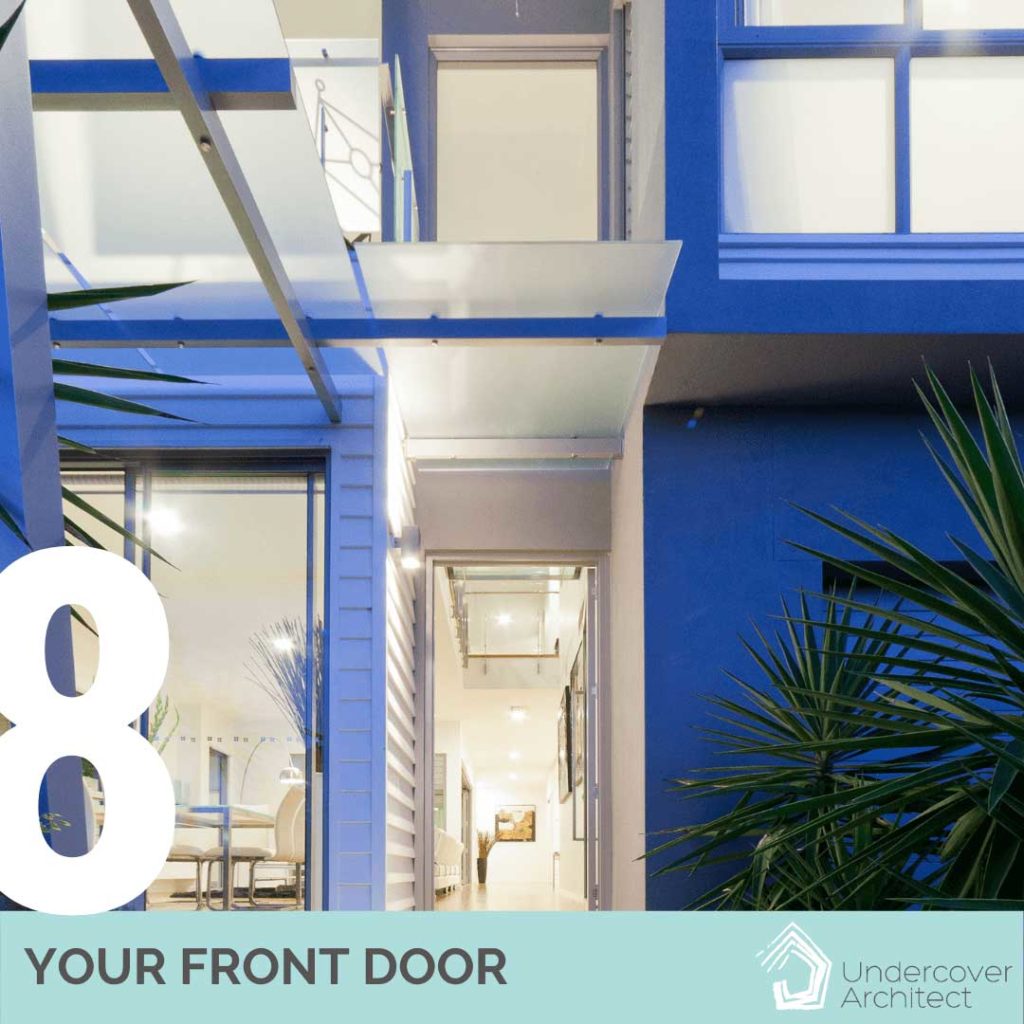
Home design by Amelia Lee | Photo by Jacob Hutson
Double door, pivot or hinge. Timber or something else?
There’s a lot of choice when it comes to the type of door opening you can have for your front door.
A hinge, 820mm door (opening size) is the fairly standard approach. But what if you want something different?
Some homeowners choose a pivot door as an option. They can be a lovely looking front door, with a really luxurious feel. They’re challenging as a front door, though, because it’s difficult to get them well sealed.
Because the pivot hinge is on the top and the bottom of the door, you can’t run a continuous seal around the perimeter edge of the door. So if your door is not well-covered, or you’re hosing outside, you can sometimes find that leaves and water will track under the door where it’s not sealed.
Double doors are another choice many make for a grand entry. And they can be great if your entry space is wide enough to house them, as you can have them both open when moving furniture in and out of the house. (Otherwise, people are often having to move larger furniture in around the back of the house).
However, I’ve seen many choose a double-door setup which is actually quite tight when only one door is open. And you usually open one door when welcoming someone into the home. So, if you’re planning a double-door entry, pick one that’s wide enough when only a single door is open.
Generally consider upgrading your front door to a 920mm door opening. You can make it taller too. Often the front door is a different material and frame to the other openings you’ll have on your front facade, and doesn’t necessarily need to align with the height of them as a result.
If choosing a timber or timber veneer, choose a timber from a sustainable resource. Be ready to regularly maintain it as well. Do your research when selecting a finish for it, so you know what expectations there are to refinish in the future.
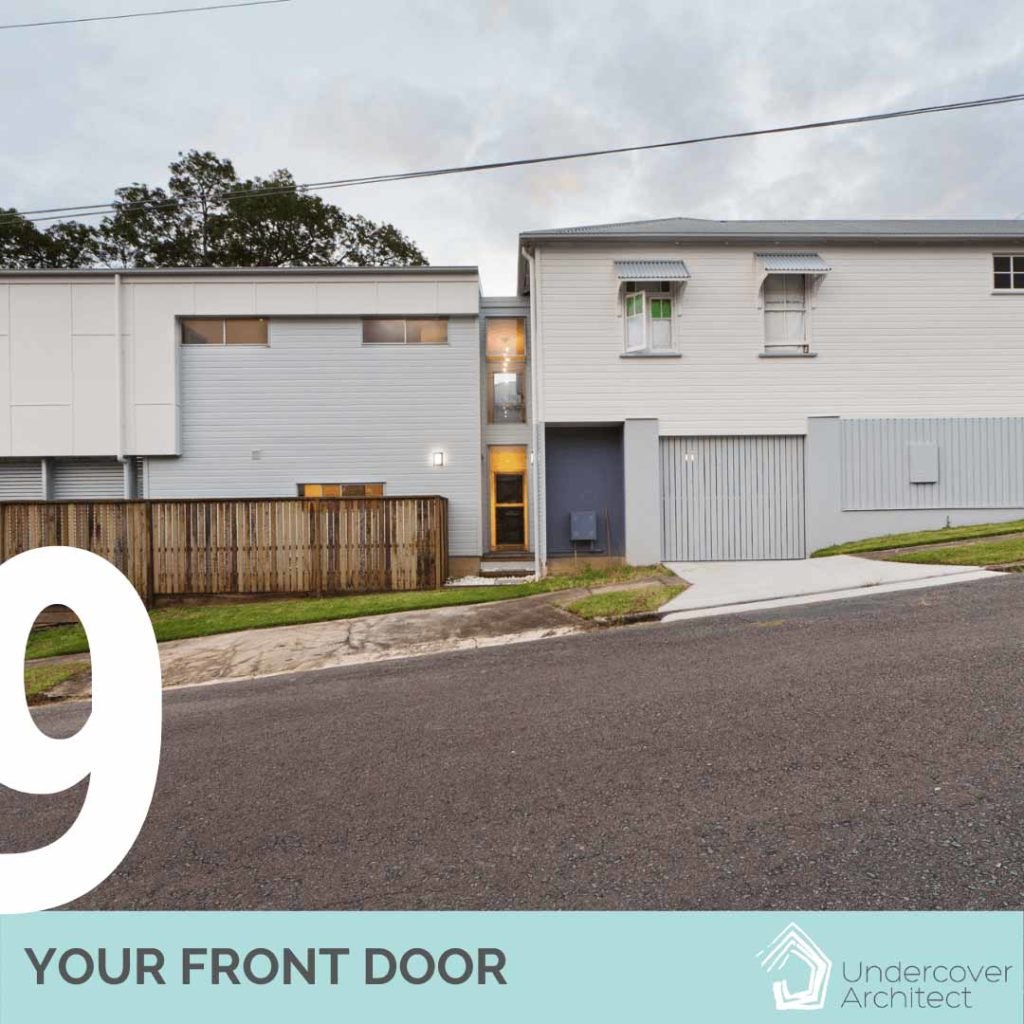
Image Source @Canva
Colour
When I lived with a friend in Surry Hills, Sydney, during my uni degree, we were in a 2 storey terrace house (in a row of terrace houses).
Every so often, she would change the door colour by giving it a new coat of paint (or two). Sometimes I wasn’t aware this was happening, and would walk straight past our place when coming home at the end of the day LOL!
Door colour has been a place of great experimentation over the past few years. With many homes using monochromatic colour schemes, the door colour is seen as a way to add personality and vibrancy. Plus, it’s a smaller area to paint should you get tired of the colour down the track.
It’s fantastic to see … yellows, pinks, greens, blues. All the colours of the rainbow – and I think it really adds some joy to the front of a home.
A few things to mention about this:
- Think about how much of the door you’ll paint in colour. Do you want to bring that colour inside too? Or will you need to figure out how to terminate the colour on a door edge (and potentially paint your architraves and skirtings in a different colour so they don’t need to continue inside too).
- Check the manufacturer’s warranty of your door. If you’re using a new door, some brands won’t warrant a door that is painted a ‘dark colour’. Check how they define ‘dark’, and ensure you won’t have issues with the door’s performance long term.
- Test the colour before you commit. Light (both night and daytime) can do strange things to colours, especially strong ones. Paint your tester the same way it’s recommended to paint the door (generally a base primer and 2 coats).
- Also test whether you want matt, satin or gloss finish to your paint. Painting a front door in gloss and getting a great result takes skill, and may not be a DIY job for you.
It’s great to have fun with colour in your home. Pick a door colour you love, and bring it into your interiors with other choices you make. If you’re worried you’ll get sick of it, highlight it through soft furnishings inside that can be easily replaced.
You’ll create a great feeling of continuity to your home, which improves that sense of ‘flow’ we all love!!
FOR MORE ON FRONT DOORS AND ENTRIES:
Be sure to listen to my podcast episode on designing your Front Entry and the front garden as well. You can listen here >>> FRONT ENTRIES + FRONT GARDENS
IMAGE SOURCES:
Images are sourced from Canva and my own personal projects. Photography by Canva and Jacob Hutson.
 With over 30 years industry experience, Amelia Lee founded Undercover Architect in 2014 as an award-winning online resource to help and teach you how to get it right when designing, building or renovating your home. You are the key to unlocking what’s possible for your home. Undercover Architect is your secret ally
With over 30 years industry experience, Amelia Lee founded Undercover Architect in 2014 as an award-winning online resource to help and teach you how to get it right when designing, building or renovating your home. You are the key to unlocking what’s possible for your home. Undercover Architect is your secret ally
Leave a Reply